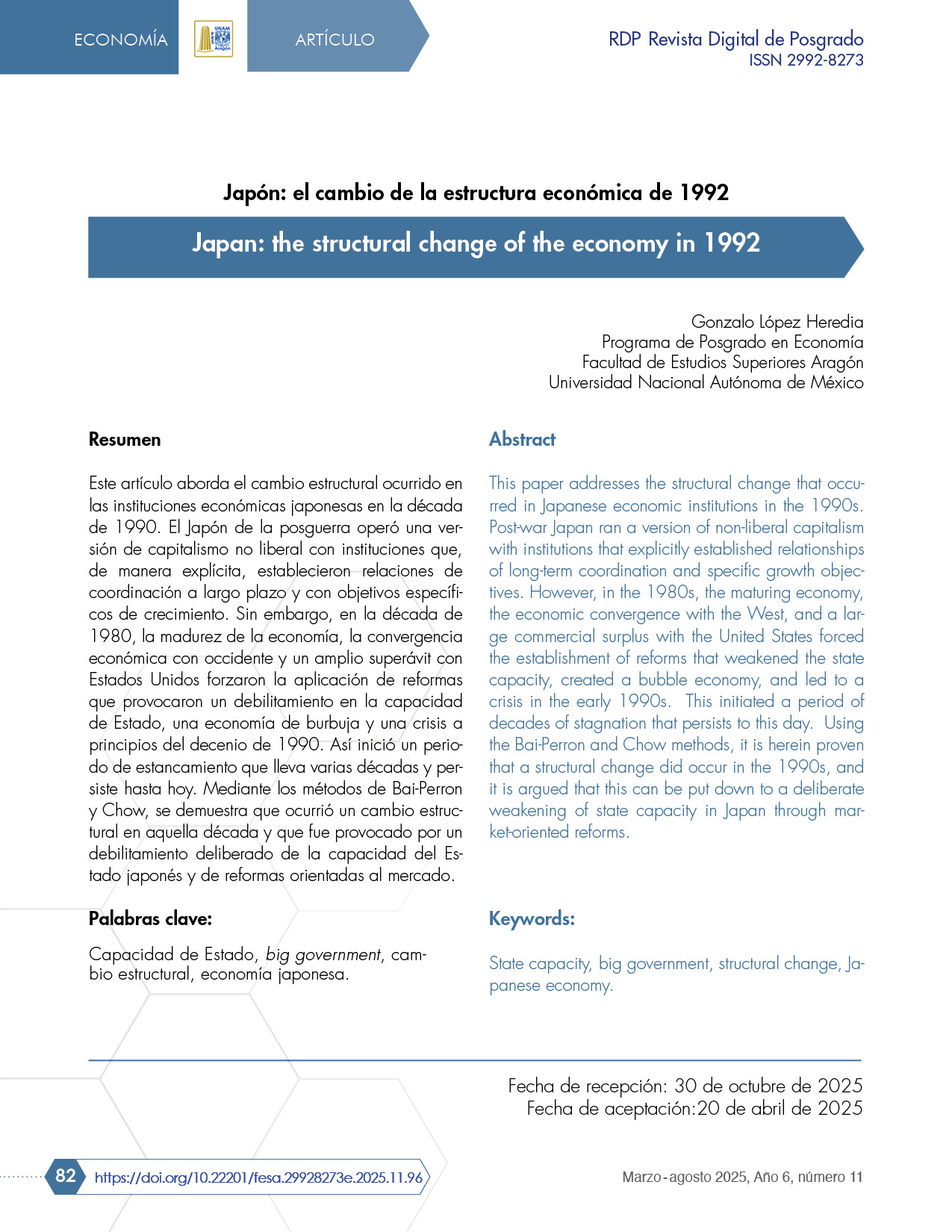Japan: the structural change of the economy in 1992
DOI:
https://doi.org/10.22201/fesa.29928273e.2025.11.96Keywords:
State capacity, big government, structural change, Japanese economy.Abstract
This paper addresses the structural change that occurred in Japanese economic institutions in the 1990s.Post-war Japan ran a version of non-liberal capitalism with institutions that explicitly established relationships of long-term coordination and specific growth objectives. However, in the 1980s, the maturing economy, the economic convergence with the West, and a large commercial surplus with the United States forced the establishment of reforms that weakened the state capacity, created a bubble economy, and led to a crisis in the early 1990s. This initiated a period of decades of stagnation that persists to this day. Using the Bai-Perron and Chow methods, it is herein proven that a structural change did occur in the 1990s, and it is argued that this can be put down to a deliberate weakening of state capacity in Japan through market-oriented reforms.
References
Bai, J. (1997). Estimating Multiple Breaks One at a Time. Econometric Theory, 13, 315–352.
Bai, J. & Perron, P. (2003). Computation and Analysis of Multiple Structural Change Models. Journal of Applied Econometrics, 6, 72–78.
Brown, R.L., Durbin, J. & Evans, J.M. (1975). Techniques for testing the constancy of regression relationships over time. Journal of the Royal Statistical Society, Series B, 149-162.
Cargill, T. F., Hutchison, M. M. & Ito, T. (2003). The political economy of Japanese monetary policy. MIT Press.
Chow, G. C. (1960). Tests of equality between sets of coefficients in two linear regressions. Econometrica: Journal of the Econometric Society, 591-605.
Eviews (s. f.). Multiple Breakpoint Testing in EViews 8. t.ly/-Vwcv.
Federal Reserve Economic Data (FRED). (2021, 8 de noviembre). Real GDP at Constant National Prices for Japan. Serie RGDPNAJPA666NRUG. Federal Reserve Bank of St. Louis. t.ly/dqXY3
Federal Reserve Economic Data (FRED). (s. f.). M1 for Japan. Serie MYAGM1JPM189N. Federal Reserve Bank of St. Louis. t.ly/xy6zX
Ginsburg, T. (2001). Dismantling the developmental state-administrative procedure reform in Japan and Korea. American Journal of Comparative Law, 49(4), 585.
Ginsburg, T. (2002). System Change? A New Perspective on Japan’s Administrative Procedure Law. Zeitschrift für japanisches Recht, 7(13), 55-84.
Higashi, C. & Lauter, P. G. (2012). The internationalization of the Japanese economy. Springer Science & Business Media.
Hoshi, T. (2002). The convoy system for insolvent banks: how it originally worked and why it failed in the 1990s. Japan and the World Economy, 14(2), 155-180.
Minsky, H. P. (2008). Stabilizing an unstable economy. McGraw-Hill.
Nishijima, S. (2012). Japanese industrial policy. Perspective of the World, 4-3.
Ohno, K. (2006). The history of Japanese economic development: The Path Traveled by Japan as a Developing Country. GRIPS Development Forum.
Ohno, K. (2018). The history of Japanese economic development: Origins of private dynamism and policy competence. Taylor & Francis.
Okazaki, T. (2017). Industrial Policy in Japan: 70-Year History since World War II. Economy, Culture & History Japan Spotlight Bimonthly.
Ozaki, R. S. (1970). Japanese views on industrial organization. Asian Survey, 10(10), 872-889.
Quandt, R. E. (1960). Tests of the hypothesis that a linear regression system obeys two separate regimes. Journal of the American statistical Association, 55(290), 324-330.
Streeck, W. & Yamamura, K. (2003). Introduction: Convergence or diversity? Stability and change in German and Japanese capitalism. En W. Streeck, & K. Yamamura (Eds.), The end of diversity: Prospects for German and Japanese capitalism. Ithaca.
Tiberghien, Y. (2011). Thirty years of neo-liberal reforms in Japan. In S. Lechevalier (Ed.), The great transformation of Japanese capitalism. Routledge.
Vogel, S., K. (1996). Freer Markets, More Rules: Regulatory Reform in Advanced Industrial Countries. Ithaca; Cornell University Press.
Weiss, L. (1998). The myth of the powerless state. Cornell University Press.
World Bank Group. (s. f.). Inflación, precios al consumidor (porcentaje anual)-Japón. https://data.worldbank.org/indicator/FP.CPI.TOTL.ZG?locations=JP

Downloads
Published
How to Cite
Issue
Section
License
Copyright (c) 2025 Universidad Nacional Autónoma de México

This work is licensed under a Creative Commons Attribution-NonCommercial-NoDerivatives 4.0 International License.




